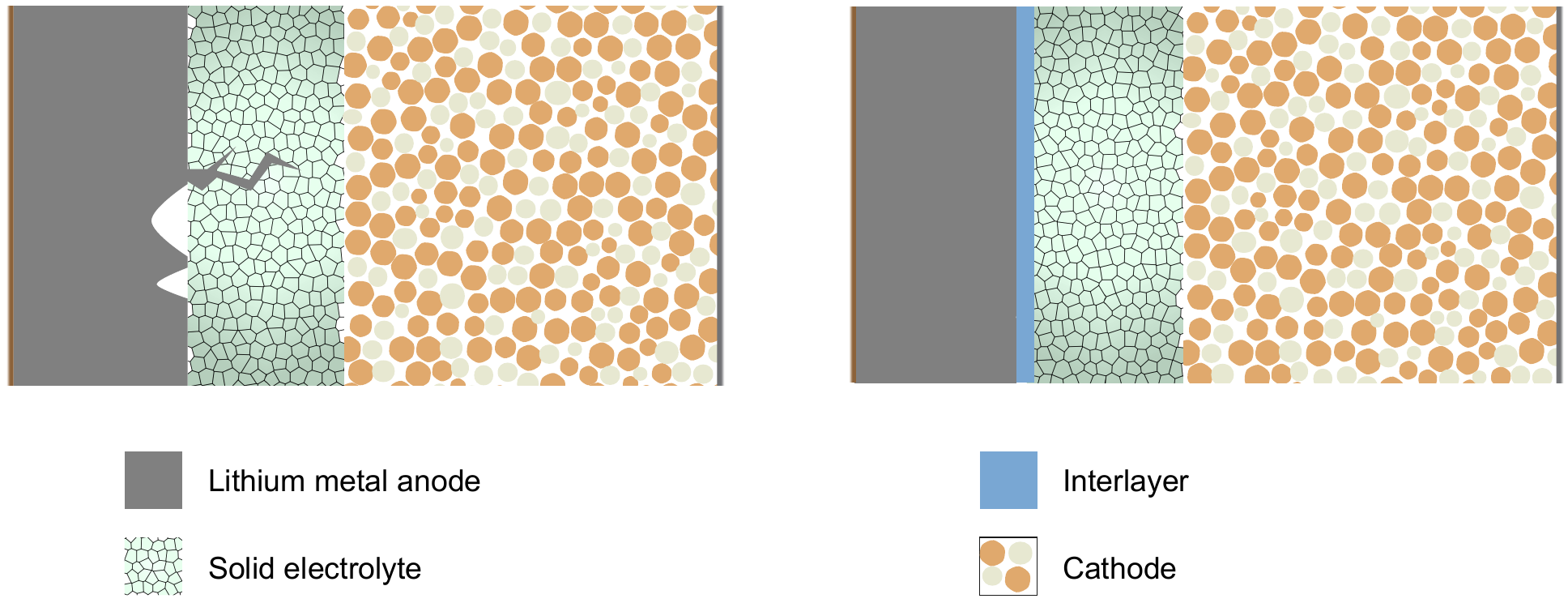At the Indian Institute of Science (IISc), scientists and their collaborators have found out how next-generation solid-state batteries fail and engineered a novel strategy to make these batteries charge faster and live longer.
 Schematic (a) represents a Li-metal solid-state battery with a discontinuous interface. These voids and discontinuities are the main driving factor for dendrite growth through solid electrolytes. These voids can be minimized by using an appropriate interlayer (b). Image Credit: Vikalp Raj.
Schematic (a) represents a Li-metal solid-state battery with a discontinuous interface. These voids and discontinuities are the main driving factor for dendrite growth through solid electrolytes. These voids can be minimized by using an appropriate interlayer (b). Image Credit: Vikalp Raj.
Solid-state batteries have been collected to substitute the lithium-ion batteries that have been found in nearly every portable electronic device. However, on being subjected to repeated or surplus use, they tend to form thin filaments known as “dendrites.” This can result in the short-circuit of the batteries and render them worthless.
In a new study published in the journal Nature Materials, the scientists have determined the primary cause of this dendrite formation. This is the look of microscopic voids in one of the electrodes at an early stage.
Furthermore, they display that the addition of a thin layer of a few metals to the electrolyte surface considerably delays the development of dendrite, thereby expanding the life of the battery and allowing it to be charged faster.
Traditional lithium-ion batteries—the type that users might find in their laptops or smartphones—consist of a liquid electrolyte that has been fixed between a negatively charged electrode (anode) made of graphite and positively charged electrode (cathode) made of a transition metal (like cobalt and iron) oxide.
When the battery has been subjected to charging and discharging (consuming power), lithium ions shuttle between the cathode and anode in opposite directions.
Such batteries face a significant safety problem—the liquid electrolyte could catch fire at high temperatures. Also, graphite has the ability to store much less charge compared to metallic lithium.
Therefore, a hopeful alternative is the solid-state batteries that switch out the liquid for a solid ceramic electrolyte and exchange graphite with metallic lithium. Better performance has been executed by ceramic electrolytes at higher temperatures, which is particularly beneficial in tropical countries like India.
Also, lithium is lighter and has the potential to store more charge compared to graphite. This considerably reduces the cost of the battery.
Unfortunately, when you add lithium, it forms these filaments that grow into the solid electrolyte, and short out the anode and cathode.
Naga Phani Aetukuri, Study Corresponding Author and Assistant Professor, Solid State and Structural Chemistry Unit, Indian Institute of Science
For this phenomenon to be executed, Aetukuri’s Ph.D. student, Vikalp Raj, artificially induced the formation of dendrite by evenly charging hundreds of battery cells. This slices out sections of the lithium-electrolyte interface and peering at them with the help of a scanning electron microscope.
When they observed closely at such sections, the team identified that something was taking place long before the dendrites were developed. Therefore, microscopic voids were getting formed in the lithium anode at the time of discharge.
Also, the team computed that the currents concentrated at the edges of such microscopic voids were nearly 10,000 times larger compared to the average currents throughout the battery cell. This was probably creating stress on the solid electrolyte and expediting the dendrite formation.
This means that now our task to make very good batteries is very simple. All that we need is to ensure that the voids don’t form.
Naga Phani Aetukuri, Study Corresponding Author and Assistant Professor, Solid State and Structural Chemistry Unit, Indian Institute of Science
To guarantee this, the scientists initiated an ultrathin layer of a refractory metal. It is a metal that is hard to heat and wear—between the solid electrolyte and lithium anode.
The refractory metal layer shields the solid electrolyte from the stress and redistributes the current to an extent.
Naga Phani Aetukuri, Study Corresponding Author and Assistant Professor, Solid State and Structural Chemistry Unit, Indian Institute of Science
Aetukuri and his research group collaborated with scientists at Carnegie Mellon University in the U. S, who performed computational analysis that clearly displayed that the refractory metal layer certainly postponed the growth of microscopic lithium voids.
Employing extreme pressure that has the potential to push lithium against the solid electrolyte can avoid voids and delay dendrite formation. However, that may not be practical for daily applications. Also, other researchers have suggested the concept of using metals like aluminum that alloy or blend well with lithium at the interface.
However, over time, this metal layer blends with lithium, thereby turning out to be interchangeable, and does not avoid the formation of dendrites.
Raj Stated, “What we are saying is different. If you use a metal like tungsten or molybdenum that doesn’t alloy with lithium, the performance which you get from the cell is even better.”
The scientists state that the findings are a crucial step forward in identifying commercial and practical solid-state batteries. Also, their strategy could also be expanded to other types of batteries that contain metals like magnesium, zinc, and sodium.
Journal Reference:
Raj, V., et al. (2022) Direct correlation between void formation and lithium dendrite growth in solid-state electrolytes with interlayers. Nature Materials. doi.org/10.1038/s41563-022-01264-8.